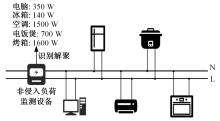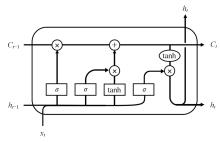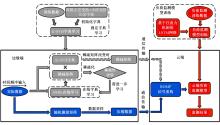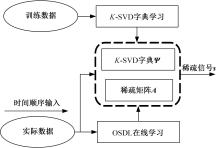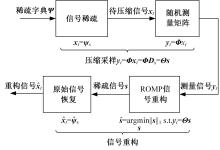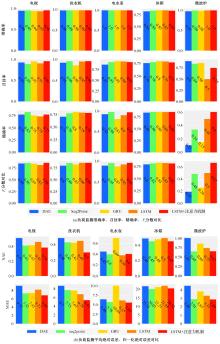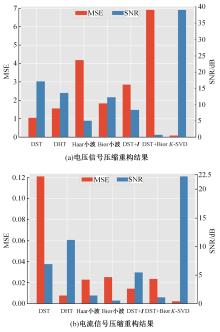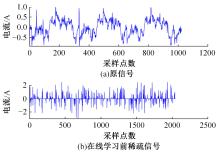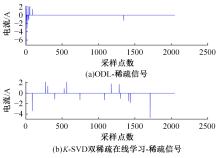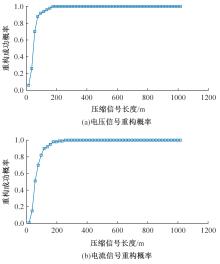Journal of Jilin University(Engineering and Technology Edition) ›› 2024, Vol. 54 ›› Issue (6): 1796-1806.doi: 10.13229/j.cnki.jdxbgxb.20220927
Non-intrusive load monitoring via online compression and reconstruction
Qiu-zhan ZHOU( ),Ze-yu JI,Cong WANG(
),Ze-yu JI,Cong WANG( ),Jing RONG
),Jing RONG
- College of Communication Engineering,Jilin University,Changchun 130012,China
CLC Number:
- TP274
| 1 | Gillis J M, Chung J A, Morsi W G. Designing new orthogonal high-order wavelets for nonintrusive load monitoring[J]. IEEE Transactions on Industrial Electronics, 2018, 65(3): 2578-2589. |
| 2 | Wang A L, Chen B X, Wang C G, et al. Non-intrusive load monitoring algorithm based on features of V⁃I trajectory[J]. Electric Power Systems Research, 2018, 157: 134-144. |
| 3 | Hart G W. Nonintrusive appliance load monitoring[J]. Proceedings of the IEEE, 1992, 80(12): 1870-1891. |
| 4 | 张露. 非侵入式负荷监测算法研究[D].广州: 华南理工大学电力学院, 2019. |
| Zhang Lu. Research on non-intrusive load monitoring algorithms[D]. Guangzhou: School of Electrial Power Engineering, South China University of Technology, 2019 | |
| 5 | 刘博. 非侵入式电力负荷监测与分解技术[D].天津:天津大学电气与自动化工程学院, 2014. |
| Liu Bo. Non-intrusive power load monitoring and disaggregation technique[D].Tianjin: School of Electrial Information Engineering, Tianjin University, 2014 | |
| 6 | Hassan T, Javed F, Arshad N. An empirical investigation of V-I trajectory based load signatures for non-intrusive load monitoring[J]. IEEE Transactions on Smart Grid, 2014, 5(2): 870-878. |
| 7 | Tsai M S, Lin Y H. Modern development of an adaptive non-intrusive appliance load monitoring system in electricity energy conservation[J]. Applied Energy, 2012, 96: 55-73. |
| 8 | Batra N, Kelly J, Parson O, et al. NILMTK: an open source toolkit for non-intrusive load monitoring[C]∥e-Energy 2014-Proceedings of the 5th ACM International Conference on Future Energy Systems.New York,USA : Association for Computing Machinery, 2014: 265-276. |
| 9 | 王轲, 钟海旺, 余南鹏, 等. 基于seq2seq和Attention机制的居民用户非侵入式负荷分解[J] .中国电机工程学报, 2019, 39(1): 75-83, 322. |
| Wang Ke, Zhong Hai-wang, Yu Nan-peng, et al. Nonintrusive load monitoring based on sequence-to- sequence model with attention mechanism[J]. Proceedings of the CSEE, 2019, 39(1): 75-83, 322. | |
| 10 | Yue Z, Witzig C R, Jorde D, et al. BERT4NILM: a bidirectional transformer model for non-intrusive load monitoring[C]∥NILM 2020-Proceedings of the 5th International Workshop on Non-Intrusive Load Monitoring.New York,USA :Association for Computing Machinery, 2020: 89-93. |
| 11 | 凌家源. 基于事件检测与深度学习的非侵入式负荷监测算法[D]. 杭州: 浙江大学电气工程学院, 2021. |
| Ling Jia-yuan. Non-intrusive load monitoring based on event detection and deep learning[D].Hangzhou: College of Electrical Engineering, Zhejiang University, 2021. | |
| 12 | Sun Y, Cui C, Lu J, et al. Data compression and reconstruction of smart grid customers based on compressed sensing theory[J]. International Journal of Electrical Power and Energy Systems, 2016, 83: 21-25. |
| 13 | Saavedra E, Mascaraque L, Calderon G, et al. The smart meter challenge: feasibility of autonomous indoor iot devices depending on its energy harvesting source and iot wireless technology[J]. Sensors, 2021, 21(22). |
| 14 | 周学斌. 智能电网海量数据轻型化方法研究[D].武汉: 武汉大学电气与自动化学院, 2020. |
| Zhou Xue-bin. Research on the method of light massive data in smart grid[D].Wuhan: School of Electrical Engineering and Automation, Wuhan University, 2020. | |
| 15 | 王大伟, 崔国宇, 庞振江, 等. 边缘计算在多芯模组化电能表中的应用研究[J]. 单片机与嵌入式系统应用, 2019, 19(4): 30-33, 37. |
| Wang Da-wei, Cui Guo-yu, Pang Zhen-jiang, et al. Application research of edge computing in multi-core modular energy meter[J]. Microcontrollers & Embedded Systems, 2019, 19(4): 30-33, 37. | |
| 16 | Donoho D L. Compressed sensing[J]. IEEE Transactions on Information Theory, 2006, 52(4): 1289-1306. |
| 17 | Candes E J, Tao T. Near-optimal signal recovery from random projections: universal encoding strategies?[J]. IEEE Transactions on Information Theory, 2006, 52(12): 5406-5425. |
| 18 | Bao K, Ibrahimov K, Wagner M, et al. Enhancing neural non-intrusive load monitoring with generative adversarial networks[J]. Energy Informatics, 2018, 1(): 295-302. |
| 19 | Linh N V, Arboleya P. Deep learning application to non-intrusive load monitoring[J]. 2019 IEEE Milan PowerTech, 2019, 2019: 2-6. |
| 20 | Vinay M B, Rekha K S. A model of saliency-based visual attention for rapid scene analysis[J]. International Journal of Recent Technology and Engineering, 2019, 7(6): 412-415. |
| 21 | Liu G, Guo J. Bidirectional LSTM with attention mechanism and convolutional layer for text classification[J]. Neurocomputing, 2019, 337: 325-338. |
| 22 | Woo S, Park J, Lee J Y, et al. Cbam: Convolutional block attention module[C]∥Proceedings of the European conference on computer vision (ECCV),Copenhagen, Denmark, 2018: 3-19. |
| 23 | Rubinstein R, Zibulevsky M, Elad M. Double sparsity: learning sparse dictionaries for sparse signal approximation[J]. IEEE Transactions on Signal Processing, 2010, 58(3): 1553-1564. |
| 24 | Mazumder R, Friedman J H, Hastie T. SparseNet: coordinate descent with nonconvex penalties[J]. Journal of the American Statistical Association, 2011, 106(495): 1125-1138. |
| 25 | Engan K, Aase S O, Husoy J H. Method of optimal directions for frame design[J]∥IEEE International Conference on Acoustics, Speech and Signal Processing-Proceedings, Piscetawar NJ: IEEE, 1999, 5: 2443-2446. |
| 26 | Aharon M, Elad M, Bruckstein A. K-SVD: an algorithm for designing overcomplete dictionaries for sparse representation[J]. IEEE Transactions on Signal Processing, 2006, 54(11): 4311-4322. |
| 27 | Lu C, Shi J, Jia J. Online robust dictionary learning[C]∥Proceedings of the IEEE Computer Society Conference on Computer Vision and Pattern Recognition,Portland,USA, 2013: 415-422. |
| 28 | Mairal J, Bach F, Ponce J, et al. Online learning for matrix factorization and sparse coding[J]. Journal of Machine Learning Research, 2010, 11: 19-60. |
| 29 | Labusch K, Barth E, Martinetz T. Robust and fast learning of sparse codes with stochastic gradient descent[J]. IEEE Journal on Selected Topics in Signal Processing, 2011, 5(5): 1048-1060. |
| 30 | Sulam J, Ophir B, Zibulevsky M, et al. Trainlets: dictionary learning in high dimensions[J]. IEEE Transactions on Signal Processing, 2016, 64(12): 3180-3193. |
| 31 | Huang K, Wu Y, Long C, et al. Adaptive process monitoring via online dictionary learning and its industrial application[J]. ISA Transactions, 2021, 114: 399-412. |
| 32 | Tropp J A, Gilbert A C. Signal recovery from random measurements via orthogonal matching pursuit[J]. IEEE Transactions on Information Theory, 2007, 53(12): 4655-4666. |
| 33 | Blumensath T, Davies M E. Iterative thresholding for saparse approximations[J]. Journal of Fourier Analysis and Applications, 2008, 14(5/6): 629-654. |
| 34 | Baraniuk R, Davenport M, DeVore R, et al. A simple proof of the restricted isometry property for random matrices[J]. Constructive Approximation, 2008, 28(3): 253-263. |
| 35 | Baraniuk R G. Compressive sensing[J]. IEEE Signal Processing Magazine, 2007, 24(4): 118-121. |
| 36 | Candes E J, Tao T. Decoding by linear programming[J]. IEEE Transactions on Information Theory, 2005, 51(12): 4203-4215. |
| 37 | Donoho D L. For most large underdetermined systems of linear equations the minimal ℓ1-norm solution is also the sparsest solution[J]. Communications on Pure and Applied Mathematics, 2006, 59(6): 797-829. |
| 38 | Needell D, Vershynin R. Uniform uncertainty principle and signal recovery via regularized orthogonal matching pursuit[J]. Foundations of Computational Mathematics, 2009, 9(3): 317-334. |
| 39 | 石光明, 刘丹华, 高大化, 等. 压缩感知理论及其研究进展[J]. 电子学报, 2009, 37(5): 1070-1081. |
| Shi Guang-ming, Liu Dan-hua, Gao Da-hua, et al. Advances in theory and application of compressed sensing[J]. Acta Electronica Sinica, 2009, 37(5): 1070-1081. | |
| 40 | Kelly J, Knottenbelt W. The UK-DALE dataset, domestic appliance-level electricity demand and whole-house demand from five UK homes[J]. Scientific Data, 2015, 2: 1-14. |
| 41 | Shalev-Shwartz S. Online learning and online convex optimization[J]. Foundations and Trends in Machine Learning, 2011, 4(2): 107-194. |
| 42 | Hoyer P O. Non-negative matrix factorization with sparseness constraints[J]. Journal of Machine Learning Research, 2004, 5: 1457-1469. |
| [1] | Ling HUANG,Zuan CUI,Feng YOU,Pei-xin HONG,Hao-chuan ZHONG,Yi-xuan ZENG. Vehicle trajectory prediction model for multi-vehicle interaction scenario [J]. Journal of Jilin University(Engineering and Technology Edition), 2024, 54(5): 1188-1195. |
| [2] | Qiu-zhan ZHOU,Ze-yu JI,Cong WANG,Ji-kang HU,Ming-ming LI,Yu-zhu CHEN,Xian-feng ZHOU,Ping-ping LIU. Seismic sensing perimeter security system based on cat swarm algorithm [J]. Journal of Jilin University(Engineering and Technology Edition), 2023, 53(4): 1187-1199. |
| [3] | Rong-han YAO,Wen-tao XU,Wei-wei GUO. Drivers' takeover behavior and intention recognition based on factor and long short⁃term memory [J]. Journal of Jilin University(Engineering and Technology Edition), 2023, 53(3): 758-771. |
| [4] | Jian-cheng WENG,Rui-cong WEI,Han-mei HE,Hai-hui XU,Jing-jing WANG. Urban road network short-term traffic flow prediction model based on associated road chain group [J]. Journal of Jilin University(Engineering and Technology Edition), 2023, 53(11): 3104-3112. |
| [5] | Qing-tian GENG,Yang ZHAO,Qing-liang LI,Fan-hua YU,Xiao-ning LI. Integrated LSTM and ARIMA method based on attention model for soil temperature [J]. Journal of Jilin University(Engineering and Technology Edition), 2023, 53(10): 2973-2981. |
| [6] | Chun-yan ZENG,Kang YAN,Zhi-feng WANG,Zheng-hui WANG. Multi-scale generative adversarial network for image compressed sensing and reconstruction algorithm [J]. Journal of Jilin University(Engineering and Technology Edition), 2023, 53(10): 2923-2931. |
| [7] | Jin-wu GAO,Zhi-huan JIA,Xiang-yang WANG,Hao XING. Degradation trend prediction of proton exchange membrane fuel cell based on PSO⁃LSTM [J]. Journal of Jilin University(Engineering and Technology Edition), 2022, 52(9): 2192-2202. |
| [8] | Hong-liang SUN,Wei-da SHEN,Ling-ling CHEN. Bandwidth compensation algorithm for mixed services under delay quality of service constraint [J]. Journal of Jilin University(Engineering and Technology Edition), 2022, 52(8): 1912-1917. |
| [9] | Da-xiang LI,Meng-si CHEN,Ying LIU. Spontaneous micro-expression recognition based on STA-LSTM [J]. Journal of Jilin University(Engineering and Technology Edition), 2022, 52(4): 897-909. |
| [10] | Xue-zhi WANG,Qing-liang LI,Wen-hui LI. Spatio⁃temporal model of soil moisture prediction integrated with transfer learning [J]. Journal of Jilin University(Engineering and Technology Edition), 2022, 52(3): 675-683. |
| [11] | Jian CHEN,Fan YU,Lin LIN,Ming⁃hui SUN. Local ultrasound array focusing method based on multiarray synthetic aperture [J]. Journal of Jilin University(Engineering and Technology Edition), 2022, 52(10): 2447-2455. |
| [12] | Zhou-zhou LIU,Qian-yun ZHANG,Xin-hua MA,Han PENG. Compressed sensing signal reconstruction based on optimized discrete differential evolution algorithm [J]. Journal of Jilin University(Engineering and Technology Edition), 2021, 51(6): 2246-2252. |
| [13] | Chun-ping HOU,Chun-yue ZHAO,Zhi-peng WANG,Hai-rui TIAN. Video anomaly detection algorithm based on effective anomaly sample construction [J]. Journal of Jilin University(Engineering and Technology Edition), 2021, 51(5): 1823-1829. |
| [14] | Yi-jun WANG,You-xu ZHANG,Rui-xin MIAO,Jia-min DOU. D2D resource allocation algorithm based on system outage probability in 5G [J]. Journal of Jilin University(Engineering and Technology Edition), 2021, 51(1): 331-339. |
| [15] | Xin-yu JIN,Mu-han XIE, SUN-Bin. Grain information compressed sensing based on semi-tensor product approach [J]. Journal of Jilin University(Engineering and Technology Edition), 2021, 51(1): 379-385. |
|
||
